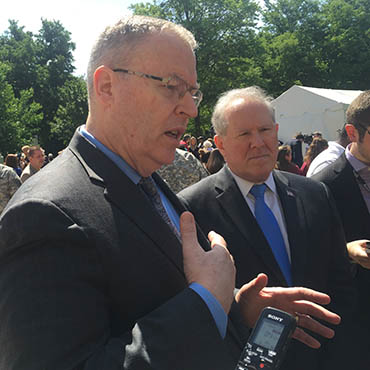DOD Lab Day has a cyber undercurrent

At the Pentagon's first-ever Laboratory Day, researchers from Air Force, Army and Navy labs won $45 million to develop quantum computing.

Deputy Secretary Robert Work (left) and Frank Kendall, undersecretary for acquisition, technology and logistics, brief reporters at the Defense Department Lab Day on May 14 at the Pentagon. (Image: Sean Lyngaas / FCW)
There weren’t many displays of cybersecurity technologies at the Defense Department Lab Day. Software, as Frank Kendall, the Pentagon’s top acquisition official, pointed out, does not necessarily lend itself to eye-catching exhibits. But cyber was where the money was at this science fair of sorts in the Pentagon courtyard on May 14.
Deputy Defense Secretary Robert Work presented a $45 million check to the Air Force, Army and Navy research labs to develop “the first U.S prototype of a scalable quantum network with memory,” as the Pentagon described the project. “This team is trying to figure out how to encrypt and then transmit information across long-range military networks for the war-fighter in a provably secure and robust fashion,” Work told a crowd of DOD researchers, high school students and reporters gathered in the courtyard.
The money comes with weighty expectations. Quantum-based computing “offers a potential billion-fold increase in computing capability” for key defense applications such as command and control, intelligence, surveillance and reconnaissance, the Pentagon said in a statement.
Funding for the project will come, over the course of three years, from the Office of the Assistant Secretary of Defense for Research and Engineering.
One of the goals of the research is to boost coordination among military research labs, Stephen Welby, deputy assistant secretary of Defense for systems engineering, told FCW. DOD researchers will also look for ad hoc applications of the technology that can be tailored to military needs.
Work put the need for the department to innovate in stark terms: “Technological superiority is not an American birthright,” and it is “under threat,” he said.
With that anxiety in mind, Pentagon officials announced last month that the department would set up its first full-time office in Silicon Valley to better connect with technological advances there. Work told reporters that if the Defense Innovation Unit Experimental (DIUX), as the office is called, is successful, officials would consider setting up similar offices in the Boston area or in other tech hubs.
Kendall, the undersecretary for acquisition, technology and logistics, added the office was meant to make communication between the Pentagon and commercial technologists more of a two-way street. “We don’t want just our people out looking for technologies. We want technologies to be coming to us,” Kendall told reporters. “And one of the reasons we’re establishing this point of presence in Silicon Valley is to get some visible presence out there, and then people will think about the DOD as a source of financing and as a potential customer.”
DIUX is supposed to be the central point of contact for entrepreneurs interested in working with the Pentagon. “We don’t want to overwhelm the valley with a whole bunch of different folks going at different points of time,” Work said.
The Air Force, however, is setting up its own Silicon Valley office to turn emerging technologies into operational capabilities. While DIUX’s portfolio includes the military services, Kendall said he was not concerned that the Air Force office would undercut DIUX as the focal point for outreach to Silicon Valley.





